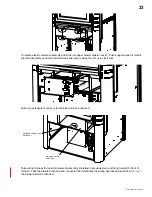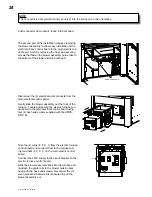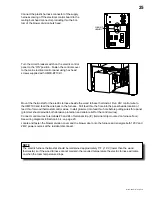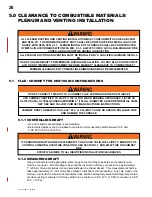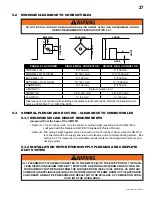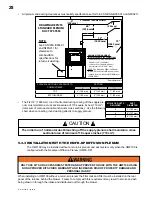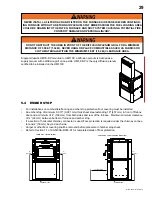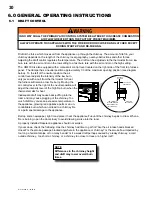
W415-1066 / A / 03.06.12
37
A CHIMNEY FIRE CAN pERMANENTLY DAMAgE YOUR CHIMNEY sYsTEM. THIs DAMAgE CAN
ONLY BE REpAIRED BY REpLACINg THE DAMAgED COMpONENT pARTs. CHIMNEY FIREs ARE
NOT COvERED BY THE LIFETIME LIMITED wARRANTY.
run-away fires can be the result of four major factors:
CAUsEs:
1.
using incorrect fuel, or small fuel pieces which would normally be used as kindling.
2.
leaving the door ajar too long and creating extreme temperatures as the air rushes in the open door.
3.
improperly installed or worn gaskets.
4.
creosote build up in the chimney.
sOLUTIONs:
1.
do not burn treated or processed wood, coal, charcoal, coloured paper or cardboard.
2.
be careful not to over fire the appliance by leaving the door open too long after the initial start-up.
3.
replace worn, dried out (inflexible) gaskets.
4.
have chimney regularly cleaned.
wHAT TO DO IF A RUN-AwAY OR CHIMNEY FIRE sTARTs:
1.
close the draft fully (lowest position) by shutting off thermostat, move air control lever fully to the left, and
make sure firebox is closed tightly.
2.
call the local fire department.
3.
examine the chimney, attic and roof of the house, to see if any part has become hot enough to catch fire.
if necessary spray with a fire extinguisher or water from a garden hose.
4.
do not operate the appliance again until you are certain the chimney has not been damaged.
7.0 mAINTENANCE
When wood is burned slowly, it produces tar and other organic vapors which combine with expelled moisture
to form creosote. These vapors condense in the relatively cooler chimney flue of a slow burning fire and when
ignited, make an extremely hot fire. check your chimney from creosote and soot build-up daily, until a safe
frequency for cleaning is established
.
The chimney connector and chimney should be inspected at least twice
monthly during the heating season to determine if a creosote build up has occurred. be aware that the hotter
the fire, the less creosote is deposited, and weekly cleaning might be necessary in mild weather, even though
substantially longer period without cleaning may be sufficient in colder months.
Also note that small intense fires are preferable to large smoldering ones to reduce the amount of creosote
deposited.
if accumulation is excessive, clean the chimney. you may want to call a professional chimney sweep to clean
it. both the chimney and the appliance have to be cleaned at least once a year or as often as necessary.
have a clearly understood plan to handle a chimney fire.
The most efficient method to sweep the chimney is using a hard brush. brush downwards so soot and
creosote residues will come off the inner surface and fall at the bottom of the chimney where they can
be removed easily.
The chimney must be checked regularly and if creosote has accumulated, it must be removed without
delay. cleaning on a monthly basis should be sufficient during the coldest months.
Smoke flue inspection
• The smoke flue should be inspected regularly during the heating season.
• if possible, the smoke flue should be dismantled and cleaned.
• The flue should be inspected for possible damage.
• if it is in good condition, put the flue back in place; otherwise, it must be replaced.
7.1 ruN-AwAy Or CHImNEy FIrE
7.2 CrEOSOTE FOrmATION ANd rEmOvAL
7.2.1 CHImNEy mAINTENANCE
Содержание HMF100
Страница 9: ...W415 1066 A 03 06 12 9 ...
Страница 43: ...W415 1066 A 03 06 12 43 11 0 service history 43 1 ...
Страница 44: ...W415 1066 A 03 06 12 44 44 1 12 0 notes ...

